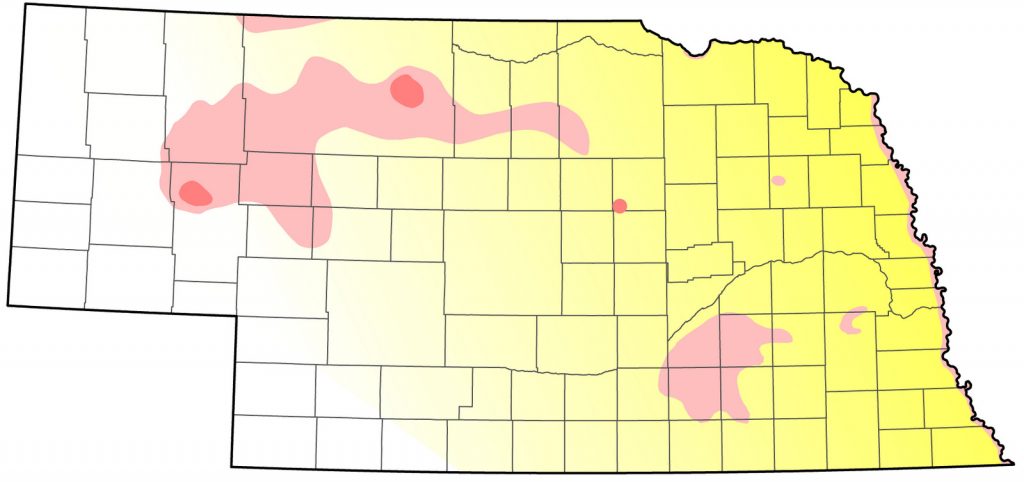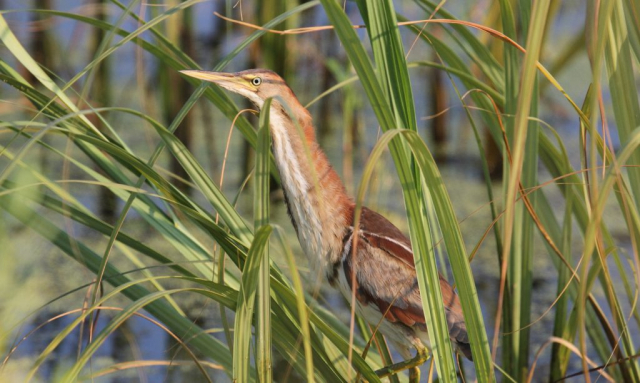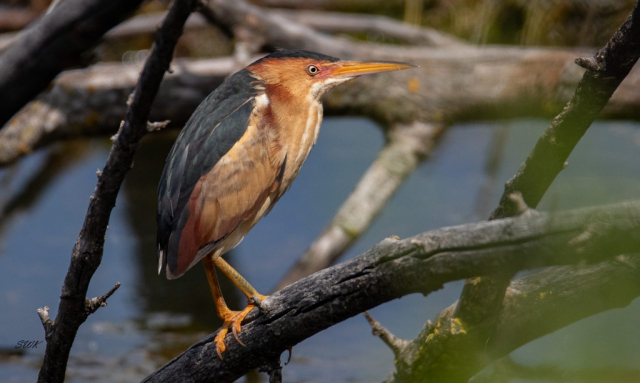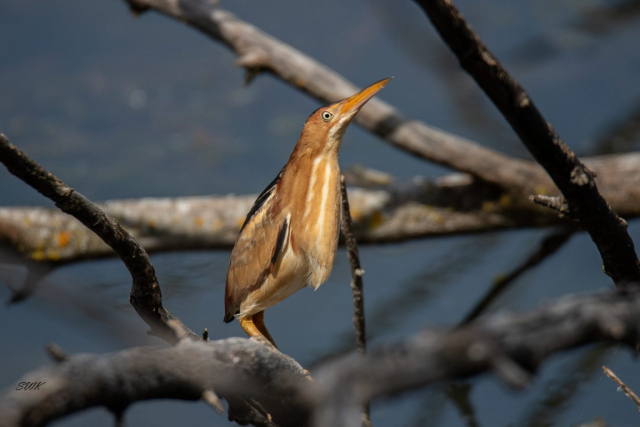Botaurus exilis EXILIS
Status: Uncommon regular spring migrant east and east central, rare elsewhere. Uncommon regular breeder north, west, and east. Rare regular fall migrant east.

Documentation: Specimen: UNSM ZM7658, 18 May 1901 Nebraska City, Otoe Co.
Taxonomy: Chesser et al (2024) merged genus Ixobrychus with Botaurus based on genetic data showing the two genera to be paraphyletic with respect to each other (Hruska et al 2023).
There are six subspecies in all, five occurring from Mexico southward (AviList 2025) and one, exilis, in North America.
Nebraska birds are exilis.
Spring: May 11, 12, 13 <<<>>> summer
Earlier dates are 14 Apr 2010 Lincoln Co, 25 Apr 2010 Fillmore Co, 27 Apr 2020 Sarpy Co, 1 May 2024 Wood Duck WMA, Stanton Co, 4 May 2024 Towl Park, Douglas Co, 7 May 2019 Lancaster Co, and 9 May 2003 Garden Co.
There is an undated report Apr 1898 at Neligh, Antelope Co (Cary 1900).
Peak migration is mid- to late May. The six reports in May 2024, all of singles in the east and east central were more than usual.
Westernmost reports that may indicate arrival dates at known Sandhills breeding locations are 13 May 1961 near Lakeside, Sheridan Co (Tremaine 1962), and a specimen, HMM 7655, taken 19 May 1914 near Oshkosh, Garden Co (Rosche 1994).
Summer: This species is associated with marshes with dense stands of emergent vegetation; many of these are dynamic with variable conditions except for certain large Sandhills marshes with relatively stable water levels. A playback study of “secretive marsh birds” in 2016-2017 (Jorgensen et al 2022, Jorgensen and Brenner 2019) resulted in 65 detections of Least Bittern in Sandhills marshes and only five in the Rainwater Basin. This discrepancy is likely due to the more variable nature of east and southeastern wetlands in Nebraska; wetter springs and summers usually yield increased sightings of this species in those sections of the state. Nevertheless, since 1973, there have been numerous breeding season reports in the southeast, many of which probably involved breeding birds. In the period 1992 through 2015 there were 35 reports in 16 of those 24 years, with concentrations in 1997-99, 2009-2010, 2014, and 2016, presumably wet years; in 2010, 15 Least Bitterns were reported.
It is probably more widespread and numerous in Sandhills marshes than the small number of records indicate due to limited coverage by observers, although there are only two confirmed Sandhills breeding records: 1938 in Garden Co (Tout 1947) and a nest in Wheeler Co 17 Jun during 1984-89 (Mollhoff 2001). It was “common in the Garden Co lakes” prior to 1925 (Swenk, Notes Before 1925). Most reports are from Crescent Lake NWR, Garden Co; a juvenile was found 18 Jul 2009, one was there 30 May 2020 and two were near Goose Lake 5 Aug 2021. Tout (1947) considered it a “common summer resident and breeder in swamps” in Lincoln Co. There are also several records for Cherry Co: in west-central Cherry Co 13 Jun; at “several sites” in Cherry Co in early Jun 2011; seven records at Valentine NWR 18-30 Jun 2006-2023. One was at Ballard’s Marsh WMA 9 Aug 2024.
There are additional western breeding season reports at Willy Lake, Sheridan Co 23 Jun 2002, at Avocet WMA, Grant Co 8 Aug 2014, in Arthur Co 15 Jun 1990 (Grzybowski 1993), and in Lincoln Co along the North Platte River 20 Jul 2009. Some of the reports listed under Spring are likely summer residents also.
Despite the number of summer reports, there are few confirmed breeding records in the east. In Lancaster Co, Cink (1971) found a nest in 1970, 4-5 nests were found in 1984 (Williams 1984, Bennett 1985) one in 1986 (Bennett 1987), one in 2003 (Carey Grell, personal communication), and 1-3, “a family”, were at Jack Sinn WMA, Lancaster Co 2-16 Jul 2014. One was at Jack Sinn WMA 31 Jul 2022, and a pair was at a Lancaster Co wetland 26-31 May 2021. In Sarpy Co, one was seen carrying nesting material in 1984 (Williams 1984), and singles were seen on several occasions at 255th St and Pflug Rd 9-30 Jul 2022. A small colony with 4-5 nests was at Massie WPA, Clay Co, 21 Jun 1981 (Jorgensen 2012), and nesting occurred at Weis WPA (now part of Mallard Haven WPA), Fillmore Co, 23 Jun 1985 (Garthright 1985). Sightings from a wetland near Niobrara SP, Knox Co 6-11 Aug 2019 and 12-21 Jun 2021 suggest summering there, likely the area now known as Niobrara Confluence WMA, where five were reported 5 Jun 2023. Two at Wood Duck WMA, Stanton Co 30 Jun 2021 were at a likely breeding location; singles were seen there on three occasions 29 Jun-23 Jul 2022.
Historically, around 1900 it was a common summer resident in the east (Bruner et al 1904, Ducey 1988), and it was a “very common summer resident and common breeder at Inland Lagoon [Harvard WPA, Clay Co] 1915-16 (Swenk, Notes Before 1925; Jorgensen 2012). The only additional reports since then until 1973 were single reports from each of Dakota and Webster Cos (Ducey 1988), Clay Co in 1971 (Jorgensen 2012), and York Co Jun 1973 (Morris 1973, Jorgensen 2012).
- Breeding Phenology:
- Courting: 1 Jun
- Eggs 21 May-23 Jul (Mollhoff 2022)
- High counts: 8 in eastern Otoe Co 5-16 Aug 1997
Fall: summer <<<>>> Aug 14, 14, 14
Later dates are 21 Aug 1997 Otoe Co, 23 Sep 2003 Knox Co, 26 Sep 1998 at Black Island WMA, Cuming Co, 2 Oct 1986 Lancaster Co (Williams 1987), 4 Oct 1999 Walnut Creek Lake, Sarpy Co, 11 Oct 2018 Knox Co, 12 Oct 2005 Hitchcock Park, Omaha, Douglas Co, 17 Oct 1983 Lancaster Co, 3 Nov 2017 Stanton Co, and 8-9 Nov 2024 Wayne Co.
Westernmost reports are 14 and 30 Aug 1986 at Keystone Lake (Rosche 1994, Williams 1987). There is a specimen, WSC 914, collected in Boone Co 13 Sep 1982 (Bray et al 1986).
Departure from breeding locations is in Aug.
Images
Abbreviations
HMM: Hastings Municipal Museum
NWR: National Wildlife Refuge
SP: State Park
UNSM: University of Nebraska State Museum
WMA: Wildlife Management Area (State)
WPA: Waterfowl Production Area (Federal)
WSC: Wayne State College
Acknowledgement
Photograph (top) of a Least Bittern at La Platte Bottoms, Sarpy Co 6 Aug 2010 by Phil Swanson.
Literature Cited
AviList Core Team, 2025. AviList: The Global Avian Checklist, v2025. https://doi.org/10.2173/avilist.v2025.
Bennett, E.V. 1985. 1984 Nebraska nesting survey. NBR 53: 46-49.
Bennett, E.V. 1987. 1986 Nebraska nesting survey. NBR 55: 31-35.
Bray, T.E., B.K. Padelford, and W.R. Silcock. 1986. The birds of Nebraska: A critically evaluated list. Published by the authors, Bellevue, Nebraska, USA.
Bruner, L., R.H. Wolcott, and M.H. Swenk. 1904. A preliminary review of the birds of Nebraska, with synopses. Klopp and Bartlett, Omaha, Nebraska, USA.
Cary, M. 1900. Some bird notes From the Upper Elkhorn. Proceedings of Nebraska Ornithologists’ Union 1: 21-29.
Chesser, R.T., S.M. Billerman, K.J. Burns, C. Cicero, J.L. Dunn, B.E. Hernandez-Banos, R.A. Jimenez, O. Johnson, A.W. Kratter, N.A. Mason, P.C. Rasmussen, and J. V. Remsen, Jr. 2024. Sixty-fifth Supplement to the American Ornithologists’ Union Check-list of North American Birds. Ornithology 141. https://doi.org/10.1093/ornithology/ukae019.
Cink, C.L. 1971. Some interesting summer bird records for Lancaster County in 1970. NBR 39: 58-59.
Dinan, L.R., M.B. Brown and J.G. Jorgensen. 2018. 2016-2017 Secretive marshbird abundance, distribution and habitat use in Nebraska. Joint report of the Nongame Bird Program of the Nebraska Game and Parks Commission and Tern and Plover Conservation Partnership. Lincoln, Nebraska, USA.
Ducey, J.E. 1988. Nebraska birds, breeding status and distribution. Simmons-Boardman Books, Omaha, Nebraska, USA.
Garthright, W.C. 1985. Fillmore County. NBR 53: 76-77.
Grzybowski, J.A. 1993. Southern Great Plains Region. American Birds 47: 1122-1124.
Hruska, J. P., J. Holmes, C. Oliveros, S. Shakya, P. Lavretsky, K. G. McCracken, F. H. Sheldon, and R. G. Moyle. 2023. Ultraconserved elements resolve the phylogeny and corroborate patterns of molecular rate variation in herons (Aves: Ardeidae). Ornithology 140: ukad005.
Jorgensen, J.G. 2012. Birds of the Rainwater Basin, Nebraska. Nebraska Game and Parks Commission, Lincoln, Nebraska, USA.
Jorgensen, J.G., and S.J. Brenner. 2019. Notable avian nesting records from the Rainwater Basin, Nebraska — 2019. Nongame Bird Program of the Nebraska Game and Parks Commission, Lincoln, Nebraska, USA.
Jorgensen, J.G., S.J. Brenner, and L.R. Greenwalt. 2022. A Tale of Two Complexes: Secretive Marsh Bird Abundance Differs in the Sandhills and Rainwater Basin, Nebraska. Wetlands 42: 41 https://doi.org/10.1007/s13157-022-01551-9.
Mollhoff, W.J. 2001. 1999-2000 Nebraska nesting report. NBR 69: 92-101.
Mollhoff, W.J. 2022. Nest records of Nebraska birds. Nebraska Ornithologists’ Union Occasional Paper Number 9.
Morris, L. 1973. Wetland birds in York County. NBR 41: 66.
Rosche, R.C. 1994. Birds of the Lake McConaughy area and the North Platte River valley, Nebraska. Chadron, Nebraska, USA.
Swenk, M.H. Notes before 1925. Critical notes on specimens in Brooking, Black, and Olson collections made subsequent to January 1, 1925. Handwritten manuscript in the Nebraska Ornithologists’ Union Archives, University of Nebraska State Museum, Lincoln, Nebraska, USA.
Tout, W. 1947. Lincoln County birds. Published by the author, North Platte, Nebraska, USA.
Tremaine, M. 1962. Excerpts from letters. NBR 30: 14.
Williams, F. 1984. Southern Great Plains Region. American Birds 38: 1035-1037.
Williams, F. 1987. Southern Great Plains Region. American Birds 41: 454-458.
Recommended Citation
Silcock, W.R., and J.G. Jorgensen. 2025. Least Bittern (Ixobrychus exilis). In Birds of Nebraska — Online. www.BirdsofNebraska.org
Birds of Nebraska – Online
Updated 13 Jul 2025



